
How do i train my dog to be obedient?
Watching your dog dart across the park ignoring your calls isn’t just frustrating—it can put them at risk near busy streets or public spaces.
It’s a classic new-puppy scene: one minute you’re gently stroking their soft fur, the next, you’re yelping as those needle-like teeth latch onto your hand. This behavior is completely normal, but teaching your puppy that human skin isn’t for chewing is one of the most vital first lessons you’ll share. It’s about more than saving your fingers; it’s about building a foundation of mutual trust and clear communication that will define your relationship for years to come.
Puppies explore the world with their mouths and learn bite inhibition—the ability to control the force of their jaw—through play with their littermates. A too-hard bite results in a startled yelp and the immediate end of the game. Your job is to continue this lesson using the same clear, consistent feedback. This positive reinforcement approach is the ethical and effective standard across the U.S. and Europe. It’s crucial to understand that physical responses like tapping a puppy’s nose or holding their mouth shut are not only culturally unacceptable and potentially illegal under animal welfare laws, but they are also counterproductive. These actions can breed fear and anxiety, often leading to more serious behavioral issues as the dog matures.

So, what does effective training look like in practice? Arm yourself with a stash of high-value chew toys and keep one handy at all times. The instant you feel teeth on skin, respond with a sharp, high-pitched “Ouch!” or “Ah-ah!” to mark the behavior. Immediately disengage by standing up and turning your back for about 30 seconds, showing that biting makes the fun disappear. The moment your puppy is calm, redirect their energy onto an appropriate toy and offer enthusiastic praise when they chew it. In an apartment, this also means puppy-proofing your space to manage their environment, protecting both your belongings and your pet from their natural chewing urges, especially during the teething phase.
This training seamlessly integrates with your broader responsibilities as a dog owner. While you’re focused on bite inhibition at home, remember that your puppy’s vaccination schedule is a legal must-do. Adhere to your vet’s plan before venturing to public spaces like parks to ensure their safety from diseases like parvovirus. As you begin practicing polite leash skills in your neighborhood, the habit of carrying poop bags and cleaning up immediately is non-negotiable. This isn’t just about courtesy; it’s a legal requirement in most American and European municipalities and a fundamental part of being a respectful member of your community. Training a soft mouth is the first step in raising a well-mannered, safe, and welcome canine citizen.

Watching your dog dart across the park ignoring your calls isn’t just frustrating—it can put them at risk near busy streets or public spaces.

New puppy owners often find themselves rushing to clean up accidents before they set in, and that’s where puppy pad training becomes a game-changer.

If you've noticed your dog's waistline disappearing and your veterinarian has mentioned those few extra pounds, your first instinct might be to simply reduce the amount of food in their bowl.

Training a dog to use a designated spot indoors isn’t as daunting as many new owners fear, but it does take consistency and an understanding of your pet’s needs.

That moment of dread on a walk is all too familiar for many new dog owners. You see another dog approaching down the sidewalk of your neighborhood

If the sight of another dog on your neighborhood walk makes your heart sink as your own dog erupts into a frenzy of barking and lunging, you're not alone.